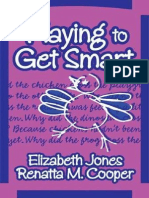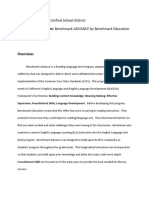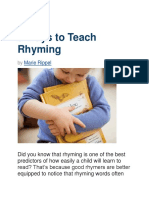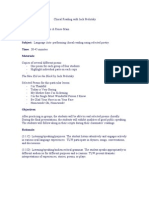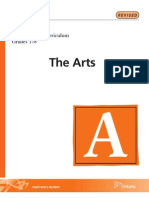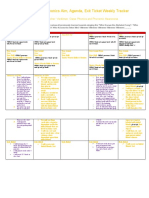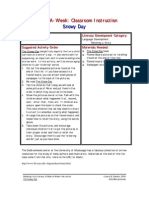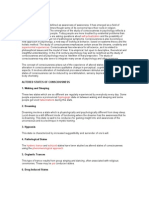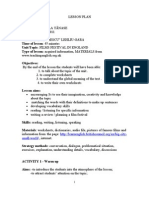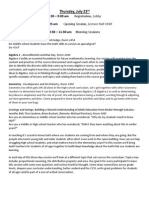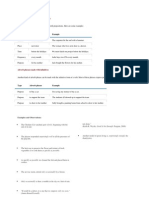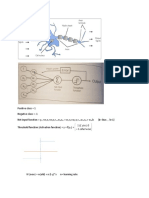Repeated Interactive Read-Alouds in Pre-School and Kindergarten
Repeated Interactive Read-Alouds in Pre-School and Kindergarten
Uploaded by
api-533726217Copyright:
Available Formats
Repeated Interactive Read-Alouds in Pre-School and Kindergarten
Repeated Interactive Read-Alouds in Pre-School and Kindergarten
Uploaded by
api-533726217Original Title
Copyright
Available Formats
Share this document
Did you find this document useful?
Is this content inappropriate?
Copyright:
Available Formats
Repeated Interactive Read-Alouds in Pre-School and Kindergarten
Repeated Interactive Read-Alouds in Pre-School and Kindergarten
Uploaded by
api-533726217Copyright:
Available Formats
LEA M.
MCGEE
J U D I T H A . S C H I C K E DA N Z
Repeated interactive read-alouds
in preschool and kindergarten
The repeated interactive read-aloud tively involved asking and answering questions and
making predictions rather than passively listening
technique is a research-based approach to (Dickinson, 2001). These read-alouds are called in-
comprehension and vocabulary teractive or dialogic and result in gains in vocabu-
lary (Hargrave & Sénéchal, 2000), comprehension
development in preschool and kindergarten.
strategies and story schema (Van den Broek, 2001),
and concept development (Wasik & Bond, 2001).
R
esearch is mixed on the value of reading
aloud to children aged 3 to 6. On one hand, Merely inviting children to talk during interactive
researchers have validated that reading read-alouds, however, is not sufficient to accelerate
aloud affects vocabulary development (Robbins & their literacy development. Instead, growth is re-
Ehri, 1994; Whitehurst et al., 1999), acquisition of lated to how frequently they engage in analytic talk
literary syntax and vocabulary (Purcell-Gates, (Dickinson & Smith, 1994). Analytic talk involves
McIntyre, & Freppon, 1995), story recall (Morrow making predictions or inferences that explain a
& Smith, 1990), and sensitivity to the linguistic and character’s motivation or connect events from dif-
organizational structures of narrative and informa- ferent parts of the story. Teachers prompt children
tional text (Duke & Kays, 1998). Studies have to engage in analytical thinking by making com-
shown that preschoolers make gains in expressive ments that model such thinking and then asking
language even when the duration of story reading thoughtful questions.
interventions are short (e.g., Hargrave & Sénéchal, Other activities boost the value of reading aloud
2000). In contrast, researchers have found only a to young children. For example, research has
modest relationship between the frequency and demonstrated that the following activities increase
quality of parent–child read-alouds during pre- comprehension and language development: inviting
school and later first-grade reading achievement preschoolers and kindergartners to retell or drama-
(Scarborough & Dobrich, 1994). Researchers have tize stories (Cornell, Sénéchal, & Brodo, 1988;
also found a negative relationship between the Pellegrini & Galda, 1982); reading several books
amount of time teachers spend reading aloud in on a similar topic and inviting children to play with
kindergarten and children’s decoding skills (Meyer, objects related to the concepts or characters intro-
Wardrop, Stahl, & Linn, 1994). These studies sug- duced in these books (Rowe, 1998; Wasik & Bond,
gest that merely reading books aloud is not suffi- 2001); reading a book repeatedly (Crago & Crago,
cient for accelerating children’s oral vocabulary 1976); inserting short definitions for some words
development and listening comprehension. Instead, while reading aloud (Collins, 2004; Elley, 1989);
the way books are shared with children matters. and encouraging children to use these same words
when they answer questions, discuss book events,
(Hargrave & Sénéchal, 2000; Robbins & Ehri,
1994), or describe illustrations (Reese & Cox, 1999).
Effective read-aloud techniques Thus, effective interactive read-alouds include a sys-
Research has demonstrated that the most effec- tematic approach that incorporates teachers’ model-
tive read-alouds are those in which children are ac- ing of higher-level thinking, asking thoughtful
742 © 2007 International Reading Association (pp. 742–751) doi:10.1598/RT.60.8.4
questions calling for analytic talk, prompting chil- vocabulary. Examples include Henny Penny
dren to recall a story in some way within a reason- (Galdone, 1968), Oonga Boonga (Wishinsky,
able time frame, reading a single book repeatedly, 2001), and Owl Moon (Yolen, 1987). These books
and reading books related by topic. It also involves can be contrasted with predictable books in which
a systematic approach to developing children’s un- readers do not need to infer character motivation,
derstanding of vocabulary, such as inserting short feelings, or thoughts in order to enjoy the repeated
definitions of words and phrases during reading. words and actions. Examples include Brown Bear,
Two recent methods for reading aloud to chil- Brown Bear, What Do You See? (Martin, l967) or
dren aged 3 to 6 include many of these research- Over in the Meadow (Wadsworth, 1992). While
based techniques. Klesius and Griffith (1996) predictable books have a role in preschool and
described a technique for reading aloud to small kindergarten literacy programs, sophisticated pic-
groups of at-risk kindergartners that they claimed ture books play an additional role of expanding vo-
extended children’s talk about books. Using inter- cabulary and enhancing oral comprehension.
active read-alouds, teachers point to details in il- Because we were aware that fewer teachers
lustrations and ask questions about vocabulary seemed to be reading sophisticated picture books as
words as they read. They extend children’s re- a daily part of their early literacy programs, we wor-
sponses by asking them to clarify and explain. ried that many children were not engaging in ana-
After reading, children recall a portion of, or the lytic talk. As we wondered how we could help
entire, story. Beck and McKeown (2001) developed teachers systematically promote this kind of talk, we
a similar technique, called Text Talk, to help considered Cochran-Smith’s (1984) argument that
kindergarten and primary-grade children expand effective teachers model the role of ideal reader as
vocabulary. As teachers read, they draw attention to they read aloud. An ideal reader is one who intu-
a few vocabulary words by inserting short defini- itively and unconsciously makes appropriate infer-
tions. They also ask open-ended questions in which ences and predictions and constantly rethinks
children must provide explanations rather than one- current events in a story in relation to past events.
or two-word responses. After reading, teachers dis- Thus, effective teachers model what ideal readers
cuss vocabulary words in the context of the story do by explicitly talking aloud as they read, making
and in other contexts. children aware that they are predicting, making an
inference, or changing their ideas about what is hap-
pening in a story. While thinking aloud is a fre-
Our experiences with effective quently used technique to help children interpret
literature in the elementary grades (e.g., Keene &
read-aloud practices Zimmerman, 1997; Miller, 2002), we wanted to
As researchers and practitioners of early liter- adapt this technique for much younger children. We
acy development, we have demonstrated and ob- wanted teachers to model making comments that
served teachers reading aloud in hundreds of would reveal implicit information that preschool and
preschool and kindergarten classrooms over the kindergarten children would not likely be able to
last three decades. Despite the wealth of research produce on their own. Therefore, we crafted an ap-
on effective read-alouds and practical models for proach to reading aloud to reflect insights drawn
such approaches, we have noticed that fewer teach- from current research and theories of an ideal read-
ers seem to be attempting to read what we consid- er as well as our own experiences. The purpose of
er sophisticated stories and nonfiction books in this article is to describe what we call repeated in-
preschool and kindergarten in favor of reading eas- teractive read-alouds using sophisticated storybooks.
ier, predictable, and concept books (often in Big
Book format), especially in classrooms with high
percentages of at-risk children. Sophisticated pic- Repeated interactive read-alouds:
ture books include, for example, stories in which
readers must infer characters’ motivations and First reading of a picture storybook
thoughts and connect them to actions (i.e., causes The first read-aloud includes four components:
and effects). These books have a rich repertoire of book introduction, vocabulary support techniques,
Repeated interactive read-alouds in preschool and kindergarten 743
analytical comments and questions, and an after- it to the castle. Let’s find out what happens to her on
reading “why” question. These techniques have the way to tell the king about the catastrophe.
been carefully selected to help children build a
stronger first understanding of the story, including We do not recommend that, during a first read,
some of its vocabulary. teachers have children identify book parts such as
the front and back cover or top and bottom of the
Book introductions page, tell what the author or illustrator does, or dis-
Research has shown that effective readers cuss the dedication page. We have found that these
quickly begin to infer story problems and use their activities divert children’s attention away from the
tentative ideas about problems to process story in- main goal of a first read-aloud—to enjoy a good
formation (Van den Broek, 2001). However, prob- story by focusing on its meaning. As we read a book
lems present challenges for young children: They during a first read, we use expression, gestures and
are often not directly stated in the text (Paris & dramatic pauses, variations in the pace of reading,
Paris, 2003; Stein & Glenn, 1979), and young chil- and plenty of eye contact. We have found these
dren are relatively insensitive to problems and techniques highly effective at capturing and main-
goals compared to characters and actions (Benson, taining children’s interest and enjoyment, even
1997; Stein & Glenn). Because young children are when reading longer and more sophisticated books.
not likely to focus on the story problem, we craft
book introductions to make the problem explicit. Inserting vocabulary support
For example, Henny Penny (Galdone, 1968) is Before reading the book aloud, we select 5 to
about a hen who mistakenly believes that a piece of 10 vocabulary words or phrases from the book that
sky has fallen on her head. She is so upset by this we will highlight or define during reading. These
event that she acts foolishly and rushes to tell the words are critical to understanding the story and
king about this occurrence. She does not recognize are likely to be encountered in other books or use-
the danger posed by the fox when he invites her ful in nonbook contexts (Beck, McKeown, &
and her friends to take a short cut right into his cave Kucan, 2002). Sometimes the book does not in-
(the actual problem of the story, which only readers clude specific vocabulary that ideal readers would
and not the characters realize). In order to construct use in their analytical thinking about this particu-
a three- or four-sentence introduction we either ex- lar book, so we insert these additional vocabulary
plicitly state or strongly imply the main problem words into the book introduction and our com-
of the story. For example, to introduce Henny ments as we read aloud. For example, we would in-
Penny we might say, sert the words mistake, catastrophe, disaster, and
In this story you are going to meet a silly, foolish hen
foolish while reading Henny Penny because these
who makes a big mistake. She thinks a catastrophe, words are critical for analyzing the problem in re-
a really bad disaster, is about to happen and runs to lationship to the main character’s motivations and
tell the king about it. A lot of her friends believe her traits. Once we select vocabulary words and phras-
mistake, and they all get in trouble because they are es, we highlight the words or enhance word and
so silly. phrase meanings in one or more of five ways:
As we give the book introduction, we show the 1. We insert a short phrase or sentence that de-
front cover and sometimes the back cover or end fines or explains a word, such as saying
papers and the title page (rather than all the illus- “Feast, that’s a really big dinner.”
trations as is done in a picture walk). For example, 2. We point to salient parts of the illustration
the front cover of Henny Penny illustrates the main that help clarify a word or phrase meaning,
character and the end papers depict Henny Penny such as pointing to the illustration of an
running up a hill toward a castle. As we show these acorn as we read the word in the text.
pages we complete the book introduction: 3. We use dramatic gestures, such as demon-
Here is Henny Penny running to tell the king about the strating the meaning of shrugged by shrug-
catastrophe. But I have to warn you, she never makes ging our shoulders as we read.
744 The Reading Teacher Vol. 60, No. 8 May 2007
4. We use voice, such as making clear the fox’s follow-up probing questions to support children’s
sly intentions by reading the text with a droll ability to answer broader explanation questions.
voice. For example, after a first reading of Henny Penny,
5. We vary the pacing with which we read we might ask the explanation question “Why didn’t
words or phrases, such as reading more Foxy Loxy just jump up and eat those silly birds?
quickly what Henny Penny says to demon- Why did he lead them into his cave?” In order to
strate her foolish rush. help children answer this question we might com-
ment, “I’m thinking that even though the fox is
It only takes a few moments to plan how to strong and has big teeth, there are a lot of birds.
support children’s understanding of each word, but How many friends were with Henny Penny?”
the most effective read-alouds are ones in which we Recalling the number of birds will help children in-
actually decide which of the vocabulary enhancers fer that the fox may have only been able to catch
we will use for each vocabulary word. For words and eat one of the birds and the others might have
that are to be clarified verbally, we plan short ex- escaped. We also help children consider this ques-
planations that are “slipped” into the story reading tion by using illustrations to support their think-
so the definitions are part of the actual story with- ing. In this version of the story, the last illustration
out interrupting the flow of reading. shows Foxy Loxy and Mrs. Loxy and their seven
children peering out from the cave. We turn to this
Comments and questions to support illustration and say, “You know I’m remembering
and extend comprehension this illustration right here. This might give me a
hint about why the fox led the birds into the cave.
During reading we make comments that
What is the hint?” This comment might help chil-
demonstrate analytic thinking at three or four junc-
dren infer that Foxy led the birds into the cave so
tures in which ideal readers would make inferences
that his children would also have a dinner, and his
about a character’s thoughts, feelings, or motiva-
wife could help catch the birds.
tions, or we predict upcoming events. When we
comment about the story, we often use language to
signal our mental activity by using the phrase “I’m
thinking.” For example, in the scene where Henny Second interactive read-aloud
Penny exclaims, “The sky is falling. I must go and Second read-alouds occur a day or two after
tell the king” (unpaged), we may comment, “I’m first reads. The purpose is to enrich children’s com-
thinking this is where the hen is doing something prehension of the story and provide further oppor-
really foolish. She isn’t even looking down to try tunities for children to engage in analytic talk.
and find out what really hit her. I think she is look- During second book introductions, we remind chil-
ing up instead of down.” Then we would go on to dren that they have read this book before and that
ask, “Why does the hen think a piece of the sky they will remember some things from the book;
has fallen on her head?” We have found that chil- for example, we might say,
dren’s answers to questions following our analyti-
cal comments are more likely to be related to the We read this book yesterday, and you probably re-
member that it is about a hen who misinterprets some-
story. This teaching sequence provides a deliber-
thing that happened to her. Who can remember what
ate and systematic approach toward expanding she thought happened to her? What was the catastro-
children’s comprehension. We have noticed that phe, and what did she decide to do about it?
most young children are not yet capable of engag-
ing in analytic thinking and talking without teacher We continue to highlight the same vocabulary;
modeling or questioning. however, in a second read we verbally define more
words. For example, during a first read of Owl
After-reading questions Moon, in which a father and a child go owling in
After reading the entire book, we ask a “why” the woods late one night, we might simply drama-
question requiring children to make inferences tize how the owl pumped his wings. During the
about and explain several story events. Then we use second read, we would dramatize pumped and
Repeated interactive read-alouds in preschool and kindergarten 745
insert a verbal explanation (e.g., “That means he events. Therefore, guided reconstructions are more
flapped his wings up and down very hard”). effective than mere retellings because children use
During the second read, we continue model- analytical talk to explain why events occurred.
ing analytic comments, but we ask more frequent In third read-aloud book introductions, we
questions that help children make additional infer- again acknowledge that children are familiar with
ences. In the first read, our comments focus on get- the book and its content and ask questions about
ting children to infer what the main character is the title or characters, such as “We’ve read this
thinking and feeling or to connect main events with book two times before, so I know you know its ti-
their causes. Thus, our comments and questions tle. What is it?” We usually allow children to re-
during the second read might focus on the other spond together to this easily answered question. We
characters’ motivations or thoughts. Just as in a first might continue to prompt children to reconstruct
read, we prepare children to answer analytical information by asking, “What other details do we
questions by first modeling analytic comments that see on the cover that we know are important for
make explicit some, but not all, of the information the story?” (e.g., prompting children to notice the
needed to adequately answer the question. For ex- acorn on the front cover of Henny Penny). We con-
ample, in Henny Penny, after Cocky Locky asks to tinue to focus on the story problem by asking, “We
join Henny Penny on her way to tell the king that all remember Henny Penny’s problem, don’t we?
the sky is falling, we might comment, “I’m think- Who would like to share that with us?” We are very
ing that Cocky Locky believes that a piece of the careful with the number of questions we ask both
sky really did fall on Henny Penny’s head.” Later, during book introductions and during guided re-
when Ducky Lucky joins Henny Penny and Cocky construction. We have found that third read-alouds
Locky, we comment, “Henny Penny has now con- can become deadly when teachers overwhelm stu-
vinced two other birds that the sky is falling.” Then dents with a barrage of questions.
we could ask, “If they had been with Henny Penny We use two general prompts in guiding recon-
when the acorn fell on her head, what do you think struction of texts. Before reading some pages of the
they would have said when she shouted, ‘Oh, my, story, we point to the illustration and ask, “What’s
the sky is falling, we must go and tell the king’?” happening here?” We use this prompt as we show
Like first reads, we end second reads by asking a double-spread illustration. Sometimes we use the
another explanation question. Sometimes we ask second question “Do you remember what will hap-
children about something that might happen be- pen next?” before turning to the next illustration.
yond the story. For example, we might ask, “What We only use this question when the next event is
do you think the king would have done if Henny causally related to the event the children have just
Penny had managed to get to the castle and told recalled. For example, in Owl Moon after recon-
him the sky was falling?” structing the event in which the characters hear the
owl hoot in response to the dad’s call, we might
ask, “Do you remember what happens next?” be-
cause this scene provides a connection to the next
Third interactive read-aloud event: seeing the owl.
Third reads occur a few days after the second After children reconstruct the events on one
read when the story is still fresh in children’s minds double spread, we might read the text. On longer
but when they must remember information across books, we reread many pages of the text and have
some time. This close repetition is also important for children reconstruct only a few pages; on shorter
reinforcing vocabulary carefully developed during books, we allow children to reconstruct more of the
the first and second read. Third interactive read- story and read only a few pages of the text. The
alouds differ from first and second read-alouds be- length of the book and children’s responses guide
cause they integrate a guided reconstruction of the our decisions of whether to read more or engage
story with the teacher’s reading of some of the story children in more reconstruction.
text. Reconstructions are retellings of story events In third reads, teachers continue to insert verbal
along with explanations about what caused those explanations of words, point to illustrations, and
events and what characters are thinking during the make dramatic motions. To further emphasize vo-
746 The Reading Teacher Vol. 60, No. 8 May 2007
TABLE 1
Components of repeated interactive read-aloud
Third read-aloud:
First read-aloud Second read-aloud Guided reconstruction
Book introduction Give a few sentences Remind children that they Invite children to identify
introducing the main know the characters and the problem and describe
character and central some things the character the solution. Have children
problem. Use illustrations does. Ask questions about recall the title of the book.
on the book cover, back, the characters and
and title page as needed. problem.
Book reading Insert vocabulary Insert vocabulary Before reading a double
enhancements for 5–10 enhancements for the page, show the illustration
vocabulary words by same vocabulary, and ask, “What is happening
pointing to illustrations, including more verbal here?” Follow up children’s
gesturing dramatically, or definitions. Make comments by extending
inserting a few definitions. comments that reveal comments or asking for
Make comments that what other characters are clarification. Read some of
reveal what the main thinking or feeling. Ask the pages of text. When
character is thinking or more analytical follow-up appropriate, before turning
feeling. Ask a few follow- questions. to the next page, ask, “Who
up analytical questions remembers what will
based on your comments. happen next?” Call
attention to some
vocabulary in different
contexts.
After-reading discussion Ask a “why” question that Ask another “why” Ask another “why”
calls for explanation. Use question or ask, “What question or ask, “What
follow-up questions to would have happened would have happened
prompt answers. if...?” Use follow-up if...?”
Demonstrate how to questions to prompt
answer the question by children’s thinking.
saying, “I’m thinking....”
cabulary in a third read, teachers extend some word Repeated interactive read-alouds
meanings to a familiar context but not one included
in the story. For example, to extend children’s un- in action
derstanding of the word pumped in Owl Moon, we Across three days of reading the same book,
might say, the strategies used in repeated interactive read-
alouds provide children with an opportunity to en-
Sometimes, when you are on the swings outside and gage more actively in the reading experience.
want help we tell you to “pump your legs,” and you During a first read, teachers take a more active role
move them back and forth to make yourself go up and by reading the text and making comments; children
back on the swing. The owl was moving his wings— are actively listening and sometimes comment or
pumping them up and down to fly through the sky. answer questions. During a second read, children
participate more verbally by answering questions
Thus, each day of the repeated interactive read- and commenting more frequently. In the third read-
aloud systematically builds and extends children’s aloud, children take a highly active role as they re-
awareness and understanding of vocabulary. Table construct the story with teacher guidance. The
1 presents an overview of the components for the following excerpts are taken from book introduc-
three days of repeated interactive read-alouds. tions in a first, second, and third read of a story.
Repeated interactive read-alouds in preschool and kindergarten 747
They demonstrate how children’s participation Teacher: She is crying. She is very upset. Now the
changes across time. front of this book (pointing) shows us the so-
lution to the problem.
First read-aloud: Book introduction Child: She happy.
In the story Oonga Boonga, no one can quiet Teacher: She is happy. What is the solution to the
problem of Baby Louise crying? (Flips to
Baby Louise who is crying so loudly that pictures back cover)
fall off walls, neighborhood animals flee, and
Several
neighbors come calling to help. Despite attempts by children: Oonga boonga.
every family member, only Louise’s brother Daniel
Teacher: (Flips to front cover) Yes, Daniel (points to
can soothe her. We read this book three times to a him on the cover) says, “oonga boonga” and
group of 4-year-olds in a Head Start center. makes her feel good. We’re going to read the
story again today and watch and see what all
Teacher: Today I’m going to read you a book called
the other people do to try and soothe Baby
Oonga Boonga, and this story is about Baby
Louise. Baby Louise is very upset. She’s
Louise (points to front cover with illustration
wailing and crying. Nobody could make her
of Baby Louise and Daniel smiling at one an-
stop.
other, then turns to the back cover and points
to illustration of Baby Louise crying). Baby Several
Louise is unhappy. She’s crying and crying, children: Oonga boonga.
and no one can stop her. I know one reason
why babies cry; they cry because they’re hun- The second book introduction was jointly con-
gry. They cry when they’re bored and want to structed by Lea and the children. Lea allowed and
see something funny. We’re going to find out encouraged spontaneous comments and prompted
why Baby Louise is crying and what will help the children to recall what they knew about the story.
her stop crying. (Turns back to front cover)
Here is Baby Louise and she’s not crying is
she? This might give us a hint about what
Third read-aloud: Guided reconstruction
stops her from crying. book introduction
In the book introduction for the third read, Lea
In this book introduction, Lea (first author) again prompted children’s active engagement by
provided reasons why babies might cry and hinted asking them to reconstruct more of the story. The
strongly at what would make Baby Louise stop children remembered much of the discussion they
crying by showing the front illustration of Daniel had during the second read-aloud and included
and Louise. She did all the talking while the chil- speculations of what might have happened if
dren were actively listening. Daniel had tried alternative ways to quiet Baby
Louise.
Second read-aloud: Book introduction
Teacher: I know you remember the title of this book.
The following day Lea read the book a second
Several
time to the children. She prompted the children to children: Oonga Boonga.
take a more active role in constructing the book
Teacher: Yes, Oonga Boonga. And who can remem-
introduction. ber the problem in the story?
Teacher: (Holds book up) Children: (Overlapping responses) Crying, brother
Daniel stopped the crying, oonga boonga.
Children: (Overlapping responses) Oonga boonga,
oonga boonga, that baby was crying, her Teacher: Yes the baby is crying and crying. Can moth-
brother came back, he say oonga boonga. er stop the baby crying?
Teacher: That’s right, yes (making eye contact with Many
many different children to affirm their com- children: No, no.
ments about the story). Now, in this story Teacher: Can father stop her?
Baby Louise has a big problem. Many
Child: She crying. children: No, no, her brother.
748 The Reading Teacher Vol. 60, No. 8 May 2007
Teacher: Yes, Daniel stopped the baby from crying, The children were able to make explicit that
and he stops her crying in two ways. The Baby Louise was crying because she wanted her
first way.... brother. They were beginning to grasp that the sil-
Several ly words her brother said had nothing to do with
children: Oonga boonga. Louise stopping crying; it was her brother she
Teacher: Yes, he says, “Oonga boonga.” The second wanted. Lea continued to explore this inference in
way he stops her crying? Do you remember? both the second and third read with different “why”
Child: Tickles her tummy. questions. By the third read, most children engaged
Teacher: Yes, we did talk that he might have tickled in a more extended analytic discussion.
her tummy when we read this two days ago.
Teacher: Now, let’s think about this. Remember I said
Child: Sings a song. yesterday, “What if Daniel had tickled her
Teacher: Yes, we did talk about that he might have belly instead of saying ‘Bonka wonka.’”
sung a lullaby. But he actually whispered Would Louise have stopped crying?
something else. Children: (Overlapping responses) No, no. He whis-
Many pered in her ear. Yes.
children: Bonka wonka. Teacher: I think she would have stopped crying.
Teacher: Yes, he said another silly thing: Bonka Child: He whistled in her ear.
wonka.
Teacher: You know, maybe if he would’ve whistled in
her ear and tickled the baby, I think she
Thus, across these three introductions, it is would have stopped crying. Because he was
clear that the children are building a richer, more her brother, and he, well, let me ask you this:
detailed understanding of the story. By the third What if her brother took her in his arms like
read, the children are clearly using analytic talk to this (turns to picture of the mother rocking
baby) and rocked her and sang her a lullaby.
move beyond what actually happened in the story
Do you think she would’ve stopped crying?
to what might have happened.
Children: (Overlapping responses) Yes, yes, no.
Teacher: (Looks at one child) I do, too. I think she
would have stopped crying. What if Daniel
Analytic talk in first and third read had taken her in his arms like this (shows il-
lustration of grandfather) and made a funny
“why” questions face at her. Do you think she would have
In the next section, we show how children’s stopped crying?
ability to use analytic talk increases from a first to a Children: (Overlapping responses) Yes, yes, no.
third interactive read-aloud. Here is their response Teacher: I think so. If Daniel played the harmonica,
to a “why” question during the first read: would it work for him?
Child: It did.
Teacher: Why was Louise crying all the time?
Teacher: I think it would work. What if Daniel gave the
Child: ’Cause her brother was, her brother was
baby a bottle? Do you think it would’ve
gone.
stopped her crying?
Teacher: Her brother wasn’t there, and why was
Child: Yes.
Louise crying?
Teacher: She really liked it when Daniel said silly
Child: ’Cause she was crying.
words, but I think she just likes her brother.
Teacher: But why was she crying?
Child: She don’t care about oonga boona. She care
Child: She wanted her brother to say, “oonga about her brother.
boonga.”
Teacher: She did want her brother. Did she want the While Lea’s original “why” question seemed
words “oonga boonga” or did she want her beyond the children’s understanding, turning to
brother? specific illustrations and posing alternative ques-
Child: Her brother. tions allowed children to be more successful in
Teacher: Yes, she just wanted her brother. both understanding the questions and making the
Repeated interactive read-alouds in preschool and kindergarten 749
inferences needed to answer them. Most children References
realized that Daniel, not the silly words, was the Beck, I.L., & McKeown, M.G. (2001). Text talk: Capturing the
key to getting Baby Louise to stop crying. benefits of read-aloud experiences for young children.
As shown in the excerpts from the three re- The Reading Teacher, 55, 10–20.
Beck, I.L., McKeown, M.G., & Kucan, L. (2002). Bringing
peated readings of Oonga Boonga, our experiences
words to life: Robust vocabulary instruction. Solving
suggest it is a powerful technique for extending problems in the teaching of literacy. New York: Guilford.
children’s vocabulary, their use of comprehension Benson, M.S. (1997). Psychological causation and goal-based
strategies, and their engagement with literature. We episodes: Low-income children’s emerging narrative
are consultants and directors of several Early skills. Early Childhood Research Quarterly, 12, 439–457.
Reading First grants currently using a repeated in- Cochran-Smith, M. (1984). The making of a reader. Norwood,
teractive read-aloud approach. While repeated in- NJ: Ablex.
teractive story reading is certainly not the only Collins, M. (2004). ESL preschoolers’ English vocabulary
acquisition and story comprehension from storybook
strategy used to enhance vocabulary and compre-
reading. Unpublished doctoral dissertation, Boston
hension in these programs, it is the most systemat- University.
ic approach. Cornell, E.H., Sénéchal, M., & Brodo, L.S. (1988). Recall of
The repeated interactive read-aloud approach picture books by 3-year-old children: Testing and repe-
requires that teachers study closely each book they tition effects in joint reading activities. Journal of
read. They must craft effective comments and ques- Educational Psychology, 80, 537–542.
tions and be able to respond on the spot to children’s Crago, H., & Crago, M. (1976). The untrained eye? A pre-
answers, which often indicate misinterpretations school child explores Felix Hoffman’s “Rapunzel.”
Children’s Literature in Education, 22, 135–151.
and misunderstandings. However, it is critical that Dickinson, D. (2001). Book reading in preschool classrooms:
teachers use these strategies so that children engage Is recommended practice common? In D.K Dickinson &
in analytical thinking. We recommend that teach- P.O. Tabors (Eds.), Building literacy with language: Young
ers read aloud a sophisticated picture book daily, children learning at home and school (pp. 175–203).
along with many other kinds of books, including Baltimore: Brookes.
predictable books. Teachers with whom we have Dickinson, D.K., & Smith, M.W. (1994). Long-term effects of
worked include repeated interactive read-alouds of preschool teachers’ book readings on low-income chil-
dren’s vocabulary and story comprehension. Reading
a sophisticated storybook or nonfiction as a part of
Research Quarterly, 29, 104–122.
their daily whole-group literacy instruction. Duke, N.K., & Kays, J. (1998). “Can I say ‘once upon a
time’?”: Kindergarten children developing knowledge of
information book language. Early Childhood Research
Final thoughts Quarterly, 13, 295–318.
Elley, W. (1989). Vocabulary acquisition from listening to
We have shown that the repeated interactive stories. Reading Research Quarterly, 24, 174–187.
read-aloud technique is a research-based approach Hargrave, A.C., & Sénéchal, M. (2000). A book reading in-
to comprehension and vocabulary development in tervention with preschool children who have limited vo-
preschool and kindergarten. We developed this ap- cabularies: The benefits of regular reading and dialogic
proach to help teachers share picture books with reading. Early Childhood Research Quarterly, 15, 75–90.
young children, especially children with few home Keene, E.O., & Zimmermann, S. (1997). Mosaic of thought:
Teaching comprehension in a reader’s workshop.
literary experiences, in ways that will allow them to
Portsmouth, NH: Heinemann.
enjoy our most sophisticated literature. It chal- Klesius, J.P., & Griffith, P.L. (1996). Interactive storybook
lenges both teachers and children to extend their reading for at-risk learners. The Reading Teacher, 49,
thinking and their literary understanding in analyt- 552–560.
ic discussions. Meyer, L.A., Wardrop, J.S., Stahl, S.A., & Linn, R.L. (1994).
Effects of reading storybooks aloud to children. Journal
of Educational Research, 88, 69–85.
McGee teaches at The Ohio State University
Miller, D. (2002). Reading with meaning: Teaching compre-
(Ramseyer Hall, 29 W. Woodruff Avenue, hension in the primary grades. Portland, ME: Stenhouse.
Columbus, OH 43210, USA). E-mail Morrow, L.M., & Smith, J.K. (1990). The effects of group size
mcgee.148@osu.edu. Schickedanz teaches at on interactive storybook reading. Reading Research
Boston University in Massachusetts. Quarterly, 25, 213–231.
750 The Reading Teacher Vol. 60, No. 8 May 2007
Paris, A.H., & Paris, S.G. (2003). Assessing narrative com- (Ed.), New directions in discourse processing (Vol. 2, pp.
prehension in young children. Reading Research 53–120). Norwood, NJ: Ablex.
Quarterly, 38, 36–76. Van den Broek, P. (2001). The role of television viewing in
Pellegrini, A.D., & Galda, L. (1982). The effects of thematic- the development of reading comprehension. Washington,
fantasy play training on the development of children’s DC: U.S. Department of Education.
story comprehension. American Educational Research
Wasik, B.A., & Bond, M.A. (2001). Beyond the pages of a
Journal, 19, 443–452.
book: Interactive book reading and language develop-
Purcell-Gates, V., McIntyre, E., & Freppon, P.A. (1995).
Learning written storybook language in school: A com- ment in preschool classrooms. Journal of Educational
parison of low–SES children in skills-based and whole lan- Psychology, 93, 243–250.
guage classrooms. American Educational Research Whitehurst, G.J., Crone, D.A., Zevnbergen, A.A., Schultz,
Journal, 32, 659–685. M.D., Velting, O.N., & Fischel, J.E. (1999). Outcomes of
Reese, E., & Cox, A. (1999). Quality of adult book reading an emergent literacy intervention from Head Start
affects children’s emergent literacy. Developmental through second grade. Journal of Educational
Psychology, 35, 20–28. Psychology, 91, 261–272.
Robbins, C., & Ehri, L.C. (1994). Reading storybooks to
kindergartners helps them learn new vocabulary words. Literature cited
Journal of Educational Psychology, 86, 54–64.
Galdone, P. (1968). Henny Penny. New York: Seabury Press.
Rowe, D. (1998). The literate potentials of book-related dra-
Martin, Jr, B. (1967). Brown bear, brown bear, what do you
matic play. Reading Research Quarterly, 33, 10–35.
Scarborough, H.S., & Dobrich, W., (1994). On the efficacy of see? New York: Holt, Rinehart and Winston.
reading to preschoolers. Developmental Review, 14, Wadsworth, O. (1992). Over in the meadow: An old counting
245–302. rhyme. New York: Scholastic.
Stein, N.L., & Glenn, C.G. (1979). An analysis of story com- Wishinsky, F. (2001). Oonga boonga. New York: Puffin
prehension in elementary school children. In R.O. Freedle Yolen, J. (1987). Owl moon. New York: Philomel Books.
Repeated interactive read-alouds in preschool and kindergarten 751
You might also like
- The Promise of Preschool From Head Start To Universal Pre-Kindergarten (Elizabeth Rose)Document289 pagesThe Promise of Preschool From Head Start To Universal Pre-Kindergarten (Elizabeth Rose)Alessandros AnckleNo ratings yet
- Spotlight On Young Children Exploring Language and Literacy ExcerptDocument8 pagesSpotlight On Young Children Exploring Language and Literacy Excerptapi-533726217No ratings yet
- Elizabeth Jones, Renatta M. Cooper Playing To Get Smart (Early Childhood Education Series (Teachers College PR) ) 2005 PDFDocument137 pagesElizabeth Jones, Renatta M. Cooper Playing To Get Smart (Early Childhood Education Series (Teachers College PR) ) 2005 PDFaeroacademic100% (1)
- Passage Reading Fluency Grade 2 Form 1 AssessorDocument1 pagePassage Reading Fluency Grade 2 Form 1 Assessorapi-345632136No ratings yet
- Benchmark Advance by Benchmark EducationDocument11 pagesBenchmark Advance by Benchmark Educationapi-449994247100% (1)
- Worksheet Missing Letters PDFDocument1 pageWorksheet Missing Letters PDFsaravanakumarNo ratings yet
- Virtue Angels of AbundanceDocument3 pagesVirtue Angels of AbundanceGabriel100% (1)
- Shared Reading A Dance Like StarlightDocument6 pagesShared Reading A Dance Like Starlightapi-488497401No ratings yet
- Connecting Right From the Start: Fostering Effective Communication with Dual Language LearningFrom EverandConnecting Right From the Start: Fostering Effective Communication with Dual Language LearningNo ratings yet
- Nature-Focused Preschools: Putting The Heart First in Environmental EducationDocument4 pagesNature-Focused Preschools: Putting The Heart First in Environmental EducationDaisyNo ratings yet
- Child Development Chart: Preschool Milestones: by Mayo Clinic StaffDocument2 pagesChild Development Chart: Preschool Milestones: by Mayo Clinic StaffZoran KošNo ratings yet
- Interactive Read AloudDocument3 pagesInteractive Read Aloudapi-526388634No ratings yet
- Preschool LabDocument6 pagesPreschool Labapi-345459234No ratings yet
- Preschool Learning Plan 1Document7 pagesPreschool Learning Plan 1api-547884261No ratings yet
- Prop Box Lesson Plan Post OfficeDocument4 pagesProp Box Lesson Plan Post Officeapi-216183591No ratings yet
- Preschool Key Developmental IndicatorsDocument2 pagesPreschool Key Developmental Indicatorsapi-269479291No ratings yet
- Who Let The Letters OutDocument7 pagesWho Let The Letters OutMum AhmadNo ratings yet
- Pals Beginning Sound AssessmentDocument34 pagesPals Beginning Sound Assessmentapi-345632136No ratings yet
- Binder Maternity Sub - 2022 For Teaching PortfolioDocument28 pagesBinder Maternity Sub - 2022 For Teaching Portfolioapi-649163161No ratings yet
- Spectrum Good Grounding Program (A Complete Pre-School Solution)Document13 pagesSpectrum Good Grounding Program (A Complete Pre-School Solution)Sharjeel Ahmed KhanNo ratings yet
- Teach RhymeDocument10 pagesTeach RhymeMari Rañada SantosNo ratings yet
- Choral Reading With Jack PrelutskyDocument3 pagesChoral Reading With Jack PrelutskyMay Grace D. SalazarNo ratings yet
- Teaching STEM in the Early Years, 2nd edition: Activities for Integrating Science, Technology, Engineering, and MathematicsFrom EverandTeaching STEM in the Early Years, 2nd edition: Activities for Integrating Science, Technology, Engineering, and MathematicsNo ratings yet
- Block PlayDocument5 pagesBlock PlayChoi Har TeeNo ratings yet
- Virtual Preschool 4.3Document6 pagesVirtual Preschool 4.3IVANANo ratings yet
- Pals Sound To Letter Segmentation AssessmentDocument24 pagesPals Sound To Letter Segmentation Assessmentapi-345632136No ratings yet
- 2020 CPG DigitalDocument32 pages2020 CPG Digitalapi-299166865No ratings yet
- Genny at in Lieu of Preschool: Please DODocument20 pagesGenny at in Lieu of Preschool: Please DOmistnehaNo ratings yet
- CK Sequence-2023 Preschool W2Document63 pagesCK Sequence-2023 Preschool W2Muhammad Adil Rehman100% (1)
- Sample Activities To Inculcate ValuesDocument66 pagesSample Activities To Inculcate ValuesImats MulintapangNo ratings yet
- Steam BookDocument21 pagesSteam Bookapi-522336289100% (1)
- Little Pea Hoot Oink Teacher's GuideDocument8 pagesLittle Pea Hoot Oink Teacher's GuideChronicleBooksNo ratings yet
- Preschool Science Experiment at Bright HorizonsDocument1 pagePreschool Science Experiment at Bright HorizonsРома ГончаренкоNo ratings yet
- Visual Arts Lesson Plan - PreschoolDocument4 pagesVisual Arts Lesson Plan - Preschoolapi-663079441No ratings yet
- Kindergarten SylllabusDocument3 pagesKindergarten Sylllabusapi-483679763No ratings yet
- Eacher S Uide: Reading Bear ContactDocument19 pagesEacher S Uide: Reading Bear ContactRenee RavalNo ratings yet
- BYU-Idaho Preschool Lesson PlanDocument9 pagesBYU-Idaho Preschool Lesson Planapi-412703399No ratings yet
- Oral Reading Assessment and Reading Fluency: Directions For Administration of Reading PassagesDocument14 pagesOral Reading Assessment and Reading Fluency: Directions For Administration of Reading PassagesNeyshell Villanueva ArañoNo ratings yet
- Preschool Planning GuideDocument74 pagesPreschool Planning GuideZachary Yassir GonzalezNo ratings yet
- Infant-Toddler ActivitiesDocument15 pagesInfant-Toddler Activitiesapi-267749246No ratings yet
- Italy - Docenti - English Language Teaching - 2016 04 - Teaching Resources - PDF - at The Theatre Lesson PlanDocument10 pagesItaly - Docenti - English Language Teaching - 2016 04 - Teaching Resources - PDF - at The Theatre Lesson Planjemilyn tungculNo ratings yet
- Oct 13-Oct 17 2014 Weekly HappeningsDocument3 pagesOct 13-Oct 17 2014 Weekly Happeningsapi-262635656100% (1)
- The Arts: RevisedDocument212 pagesThe Arts: Revisedfindley26No ratings yet
- Monthly Book Report Fantastic Mr. FoxDocument2 pagesMonthly Book Report Fantastic Mr. FoxNguyễn Đức Thành AnNo ratings yet
- Learning Through GamesDocument33 pagesLearning Through GamesImran AminNo ratings yet
- Hands On Home Learning For PreschoolDocument42 pagesHands On Home Learning For PreschoolMs. Lupita BetancourtNo ratings yet
- Fall Thematic UnitDocument8 pagesFall Thematic Unitapi-584804285No ratings yet
- BYU-Idaho Preschool Lesson Plan Lesson Plan #28: Lab 4 TurtlesDocument11 pagesBYU-Idaho Preschool Lesson Plan Lesson Plan #28: Lab 4 Turtlesapi-400179769No ratings yet
- Phonics LessonDocument3 pagesPhonics Lessonapi-248067887No ratings yet
- Sensory Experiences Through Play in the Classroom: Teachers Resource Series, #4From EverandSensory Experiences Through Play in the Classroom: Teachers Resource Series, #4No ratings yet
- Alabama Literacy Act Parent ActivitiesDocument6 pagesAlabama Literacy Act Parent ActivitiesstacyejonesNo ratings yet
- Kindergarten Weekly Phonics Lesson Plan - L and R Blends - VardimanDocument2 pagesKindergarten Weekly Phonics Lesson Plan - L and R Blends - VardimanKIPPNYCDocs100% (1)
- ShapeTreeFallPreschoolActivity 1Document7 pagesShapeTreeFallPreschoolActivity 1Nathalia OmenaNo ratings yet
- Snowy Day LessonDocument9 pagesSnowy Day LessonAngeliquita MaríaNo ratings yet
- Enki Gr2 Cuisenaire Rod WorkbookDocument96 pagesEnki Gr2 Cuisenaire Rod Workbookjayashreec6No ratings yet
- Freckle Parent Letter-ElementaryDocument1 pageFreckle Parent Letter-Elementaryapi-351979596No ratings yet
- Seasons Language Arts Lesson PlanDocument2 pagesSeasons Language Arts Lesson Plankristenereeves100% (1)
- Academic Vocabulary Words For 1st GradersDocument9 pagesAcademic Vocabulary Words For 1st GradersZaher AttawnehNo ratings yet
- Talk For Writing - Y3-Unicorn-FDocument33 pagesTalk For Writing - Y3-Unicorn-FChong Beng LimNo ratings yet
- The Mitten Lesson SeriesDocument17 pagesThe Mitten Lesson Seriesapi-249528937No ratings yet
- Teaching Number Concepts Through GamesDocument45 pagesTeaching Number Concepts Through GamesYan ChenNo ratings yet
- Stories of The Seasons PDFDocument12 pagesStories of The Seasons PDFFendi AmeenNo ratings yet
- Module 6Document4 pagesModule 6api-533726217No ratings yet
- 6.3 How Picture Books Work: Anisha BadeshaDocument7 pages6.3 How Picture Books Work: Anisha Badeshaapi-533726217No ratings yet
- Module 5Document3 pagesModule 5api-533726217No ratings yet
- Module 4Document10 pagesModule 4api-533726217No ratings yet
- Module 4Document6 pagesModule 4api-533726217No ratings yet
- Module 6Document8 pagesModule 6api-533726217No ratings yet
- Community Lesson PlanDocument4 pagesCommunity Lesson Planapi-533726217No ratings yet
- Module 2Document9 pagesModule 2api-533726217No ratings yet
- Self Portrait Lesson Plan RevisedDocument4 pagesSelf Portrait Lesson Plan Revisedapi-533726217No ratings yet
- Dinosaur Lesson PlanDocument3 pagesDinosaur Lesson Planapi-533726217No ratings yet
- Lesson PlanDocument4 pagesLesson Planapi-533726217No ratings yet
- Kindergarten Intro Lesson Science SeasonsDocument2 pagesKindergarten Intro Lesson Science Seasonsapi-533726217No ratings yet
- Module 2Document7 pagesModule 2api-533726217No ratings yet
- Lesson Planning Template Created By: Anisha Badesha Subject: Language Arts Grade: KDocument6 pagesLesson Planning Template Created By: Anisha Badesha Subject: Language Arts Grade: Kapi-533726217No ratings yet
- Module 2Document5 pagesModule 2api-533726217No ratings yet
- NVSD Unit Planner 1Document2 pagesNVSD Unit Planner 1api-533726217No ratings yet
- Module 7 - Unit Plan Part 2Document13 pagesModule 7 - Unit Plan Part 2api-533726217No ratings yet
- lgbtq2 SecrettDocument4 pageslgbtq2 Secrettapi-533726217No ratings yet
- Module 4Document2 pagesModule 4api-533726217No ratings yet
- Sharing Circle Instructions SecondaryDocument4 pagesSharing Circle Instructions Secondaryapi-533726217No ratings yet
- Module 3Document2 pagesModule 3api-533726217No ratings yet
- SyntaxDocument4 pagesSyntaxAtahualpa DazaNo ratings yet
- Dooly in PressDocument15 pagesDooly in Pressjudithgm9966No ratings yet
- ESL Brains Life Used To Be Different SV 1234Document3 pagesESL Brains Life Used To Be Different SV 1234Marian ArteagaNo ratings yet
- Different Types of ThinkingDocument5 pagesDifferent Types of ThinkingEthan LawNo ratings yet
- Mysticism Occultism Self-ActualizationDocument7 pagesMysticism Occultism Self-Actualizationapi-27388181No ratings yet
- Unpacking of English 5 1 Quarter: San Vicente Elementary SchoolDocument3 pagesUnpacking of English 5 1 Quarter: San Vicente Elementary SchoolTeresa Medina TicsayNo ratings yet
- Learning Episode 5: Creating An Appropriate Learning EnvironmentDocument13 pagesLearning Episode 5: Creating An Appropriate Learning EnvironmentMarwin Rebollos ApolinarioNo ratings yet
- The Way To HappinessDocument5 pagesThe Way To Happinessskywalker76No ratings yet
- NELTAL ProceedingsDocument290 pagesNELTAL Proceedingsainkqe0% (1)
- Portfolio in ELT 208 (Language and Learning Materials Development)Document8 pagesPortfolio in ELT 208 (Language and Learning Materials Development)Dyra P. VillacanasNo ratings yet
- Family of Origin QUESTIONSDocument4 pagesFamily of Origin QUESTIONSRafael do Nascimento de AndradeNo ratings yet
- Writing A Literature Review: Section AimDocument9 pagesWriting A Literature Review: Section AimPaul IacobNo ratings yet
- Lesson Plan British CouncilDocument5 pagesLesson Plan British CouncilAnonymous hVV6Zk0No ratings yet
- TMC 2015 ProgramDocument20 pagesTMC 2015 Programtina_cardone1No ratings yet
- Module 21 Student's Diversity in Motivation (Enero and Recilla)Document14 pagesModule 21 Student's Diversity in Motivation (Enero and Recilla)reimarjohnrNo ratings yet
- Adverb Phrases Made With PrepositionsDocument2 pagesAdverb Phrases Made With PrepositionsUya MadaniNo ratings yet
- Numeric Example For PerceptronDocument6 pagesNumeric Example For PerceptronAysun GüranNo ratings yet
- Pragmatics and StylisticsDocument7 pagesPragmatics and StylisticsAri A. ResulNo ratings yet
- MMW LecturesDocument5 pagesMMW LecturesJohn Rancel MulinyaweNo ratings yet
- Organizational Behavior: Chapter 5: Personality and ValuesDocument14 pagesOrganizational Behavior: Chapter 5: Personality and ValuesDewi Astuti100% (1)
- MOANS Trails, Stroop, FASDocument52 pagesMOANS Trails, Stroop, FASJennifer CaussadeNo ratings yet
- Strategies For The Written Expression QuestionsDocument6 pagesStrategies For The Written Expression QuestionsAbdul Rapiq PaneNo ratings yet
- The Oral Approach and Situational Language TeachingDocument4 pagesThe Oral Approach and Situational Language TeachingFardhi Afindra Putra0% (1)
- Grade 5 WHL WEEK 3Document4 pagesGrade 5 WHL WEEK 3vanessa abandoNo ratings yet
- Introduction To Organizational BehaviorDocument6 pagesIntroduction To Organizational BehaviorRajeev SubediNo ratings yet
- Tugas Tutorial 1 - SociolinguisticsDocument3 pagesTugas Tutorial 1 - Sociolinguisticslotus373No ratings yet
- Past Simple Passive Form Reported Speech Imperatives Should and Must (For Obligations)Document31 pagesPast Simple Passive Form Reported Speech Imperatives Should and Must (For Obligations)SyaZana ShahromNo ratings yet


